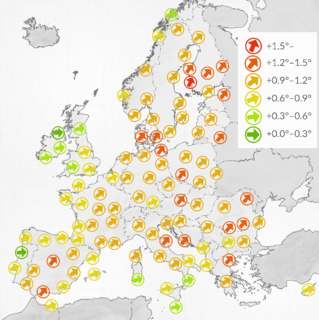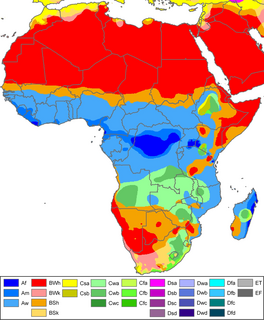
The Kyoto Protocol is an international treaty which extends the 1992 United Nations Framework Convention on Climate Change (UNFCCC) that commits state parties to reduce greenhouse gas emissions, based on the scientific consensus that (part one) global warming is occurring and (part two) it is extremely likely that human-made CO2 emissions have predominantly caused it. The Kyoto Protocol was adopted in Kyoto, Japan, on 11 December 1997 and entered into force on 16 February 2005. There are currently 192 parties (Canada withdrew from the protocol, effective December 2012) to the Protocol.

Carbon neutrality refers to achieving net zero carbon dioxide emissions by balancing carbon dioxide emissions with removal or simply eliminating carbon dioxide emissions altogether. It is used in the context of carbon dioxide-releasing processes associated with transportation, energy production, agriculture, and industrial processes. Carbon-neutral status can be achieved in two ways:

Climate change mitigation consists of actions to limit global warming and its related effects. This generally involves reductions in human emissions of greenhouse gases (GHGs).

Renewable energy plays an important and growing role in the energy system of the European Union. The share of energy from renewable sources in gross final consumption of energy was 18% in 2018. This is double the share in 2004 with 8.5%. The Europe 2020 strategy includes a target of reaching 20% of gross final energy consumption from renewable sources by 2020, and at least 32% by 2030. These figures are based on energy use in all its forms across all three main sectors, the heating and cooling sector, the electricity sector and the transport sector.
A low-carbon economy (LCE), low-fossil-fuel economy (LFFE), or decarbonised economy is an economy based on low-carbon power sources that therefore has a minimal output of greenhouse gas (GHG) emissions into the atmosphere, specifically carbon dioxide. GHG emissions due to anthropogenic (human) activity are the dominant cause of observed global warming since the mid-20th century. Continued emission of greenhouse gases may cause long-lasting changes around the world, increasing the likelihood of severe, pervasive, and irreversible effects for people and ecosystems.
Strict sustainability standards for biofuel in the European Union (EU) are set by the European Commissioner on Energy. Biofuels are considered a renewable alternative to fossil fuels in the transportation sector for the EU. The EU has played a large role in increasing the use of biofuels in member states; however, it has also aimed, to some extent, to mitigate the potential negative impacts of biofuel production. Current EU legislation on biofuels includes a goal to increase renewable energy consumption by 20%, eliminate biofuel feedstock sourced from carbon-rich land, accounting for emissions caused from land use change as well as solely biofuel usage, and reducing greenhouse gas intensities from fuels used in transport and machinery.
The European plan on climate change consists of a range of measures adopted by the members of the European Union to fight against climate change. The plan was launched in March 2007, and after months of tough negotiations between the member countries, it was adopted by the European Parliament in December 2008. The package focuses on emissions cuts, renewables and energy efficiency.

Climate change in Canada has wide ranging impacts on the natural environment and population of Canada. According to the 2019 report Canada's Changing Climate Report (CCCR) which was commissioned by Environment and Climate Change Canada, Canada's annual average temperature over land has warmed by 1.7 C since 1948. The rate of warming is even higher in Canada's North, in the Prairies and northern British Columbia. The country's average amount of precipitation has increased since 1950 and extreme weather events are increasingly a concern. For example, British Columbia experienced heat waves in 2009 that increased respiratory illness and flooding in 2010 that destroyed the Bella Coola highway.

Climate change in the United Kingdom is leading to a range of impacts on the natural environment and humans including increasing storms, floods, heatwaves and sea level rise.

In 2018, net greenhouse gas emissions in the United Kingdom were 451.1 million tonnes CO2 equivalent. Emission in the UK decreased in the 2010s due to the closure of almost all coal-fired power stations, but as of 2018 emissions per person were still above the world average.

Climate change in Finland is an issue that many people in Finland feel strongly about. Finland was among the top five greenhouse gas emitters in 2001, on a per capita basis. Emissions increased to 58.8 million tonnes in 2016. Finland needs to triple its current cuts to emissions in order to be carbon neutral by 2035. Finland relies on coal and peat for its energy, but plans to phase out coal by 2029. Police estimate that 10,000 people attended the April 2019 climate peace march in Helsinki. In January 2020 99% of Finns said action must be taken to stop climate change.

Climate change in Europe describes the climate change related issues in Europe. This includes the climate politics, contribution in the global warming and the influence of the global warming in Europe. According to international climate experts global temperature rise should not exceed 2 °C to prevent the most dangerous consequences of the climate change. It was also made essential to halve greenhouse gases such as carbon dioxide by 2050 compared to the 1990 levels. Other countries such as Brazil and China will also reduce emissions by between 80% and 95% by 2050. It is estimated that from the now living persons alive are 70% in the year 2050. Emission reduction means development and implementation of new energy technology solutions. Some people consider that the technology revolution has already started in Europe since the markets for renewable technology have annually grown.
The German Climate Action Plan 2050 is a climate protection policy document approved by the German government on 14 November 2016. The plan outlines measures by which Germany can meet its various national greenhouse gas emissions reduction goals through to 2050 and service its international commitments under the 2016 Paris Climate Agreement. The Federal Ministry for the Environment, Nature Conservation, Building and Nuclear Safety (BMUB), under minister Barbara Hendricks, led the development of the plan. The plan was progressively watered down since a draft was first leaked in early May 2016. Projections from the environment ministry in September 2016 indicate that Germany will likely miss its 2020 climate target.

Climate change in Germany is leading to long-term impacts on agriculture in Germany, more intense heatwaves and coldwaves, flash and coastal flooding, and reduced water availability. Debates over how to address these long-term challenges caused by climate change have also sparked changes in the energy sector and in mitigation strategies. Germany's energiewende has been a significant political issue in German politics that has made coalition talks difficult for Angela Merkel's CDU.

The California Global Warming Solutions Act of 2016: emissions limit, or SB-32, is a California Senate bill expanding upon AB-32 to reduce greenhouse gas (GHG) emissions. The lead author is Senator Fran Pavley and the principal co-author is Assemblymember Eduardo Garcia. SB-32 was signed into law on September 8, 2016, by Governor Edmund Gerald “Jerry” Brown Jr. SB-32 sets into law the mandated reduction target in GHG emissions as written into Executive Order B-30-15.
Air pollution in Germany has significantly decreased over the past decade. Air pollution occurs when harmful substances are released into the Earth's atmosphere. These pollutants are released through human activity and natural sources. Germany took interest in reducing its greenhouse gas (GHG) emissions by switching to renewable energy sources. Renewable energy use rose from 6.3% in 2000 to 34% in 2016. Through the transition to renewable energy sources, some people believe Germany has become the climate change policy leader and renewable energy leader in the European Union (EU) and in the world with ambitious climate change programs, though Germany's CO2 emissions per capita are in fact among the highest in Europe, almost twice those of e.g. France. The current goal of the German government was approved on 14 November 2016 in the German Climate Action Plan 2050, which outlines measures by which Germany can meet its greenhouse gas emissions by 2050. By 2050, Germany wants to reduce their GHGs by 80 to 95% and by 2030 they want to reduce it by 55%, compared to the EU target of 40%.

Greenhouse gas emissions by Turkey are mainly carbon dioxide from burning coal, oil and natural gas. Most coal is burnt in the nation's power stations. Oil is refined and fuels almost all Turkey's cars, trucks. and planes, Natural gas heats buildings and generates electricity. Growing forests take up some carbon dioxide, but not nearly as much as is being discharged into the air. Turkey emits about 500 million tonnes of human-made greenhouse gas (GHG) every year, which is around one percent of the world's total.

The European Green Deal is a set of policy initiatives by the European Commission with the overarching aim of making Europe climate neutral in 2050. An impact assessed plan will also be presented to increase the EU's greenhouse gas emission reductions target for 2030 to at least 50% and towards 55% compared with 1990 levels.

Climate change in the Middle East and North Africa (MENA) refers to changes in the climate of the MENA region and the subsequent response, adaption and mitigation strategies of countries in the region. In 2018, the MENA region emitted 3.2 billion tonnes of carbon dioxide and produced 8.7% of global greenhouse gas emissions (GHG) despite making up only 6% of the global population. These emissions are mostly from the energy sector, an integral component of many Middle Eastern and North African economies due to the extensive oil and natural gas reserves that are found within the region.

Climate change has highly impacted South Africa, primarily due to increased temperatures and rainfall variability. Evidence shows that extreme weather events are becoming more prominent due to climate change. This is a critical concern for South Africans as climate change will affect the overall status and wellbeing of the country, for example with regards to water resources. Just like many other parts of the world, climate research showed that the real challenge in South Africa was more related to environmental issues more than developmental ones. The most severe effect will be targeting the water supply, which has huge effects on the agriculture sector. Speedy environmental changes are resulting clear effects on the community and environmental level in different ways and aspects, starting with air quality, to temperature and weather patterns, reaching out to food security and disease burden.















